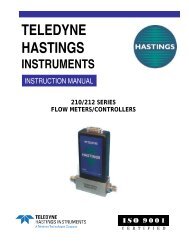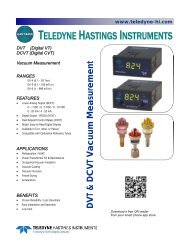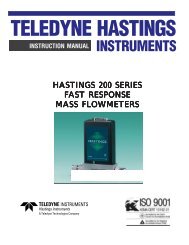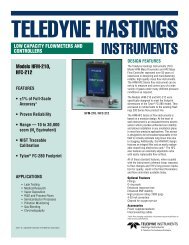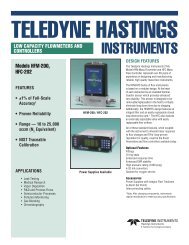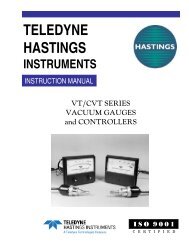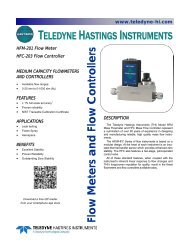Model 282 - Teledyne Hastings Instruments
Model 282 - Teledyne Hastings Instruments
Model 282 - Teledyne Hastings Instruments
Create successful ePaper yourself
Turn your PDF publications into a flip-book with our unique Google optimized e-Paper software.
5.0 CALIBRATION AND TROUBLESHOOTING GUIDEAll <strong>Hastings</strong> Vacuum Gauges and Gauge Tubes have been carefully checked and calibrated at the factory before shipment. Ifa calibration check is desired, the methods in the following sections may prove helpful.5.1 Checking of Tube:The simplest and quickest method of checking operation and calibration of a gauge tube is to keep a new spare clean gaugetube on hand as a “standard”. To check operation, install both new and old gauge tubes together in the same clean, dryvacuum system, and pump until a steady pressure is obtained. Plug the gauge onto both tubes alternately and checkreadings. If the old tube reads a higher pressure than the new one, this indicates a shift in the old tube which is mostprobably the result of tube contamination. Calibration can possibly be restored by gently swishing solvent such as acetone,or ethyl alcohol in the tube end. After cleaning, thoroughly air dry the tube. (Caution: Do not use high pressure air jet, as thiswill damage the thermopile and damage gauge tube.) If calibration cannot be restored by this procedure, replace the oldtube with a new gauge tube. The two tubes can track one another within close tolerance, however, variance of up to 2x ofaccuracy specification stated for tube may be seen, or check the gauge tube by method described in Section 5.2.CAUTION: Do not attempt to measure the resistance of the gauge tube element with a DVM while it is under hard vacuumunless it supplies less than 350mV to perform measurement, or more than 929mV at 15 Torr, and never more than 1.5V atATM between pins 2 (Black) and 8 (Red). A good tube will read around 25-30 ohms. If open or damaged, thermocoupleswill read much higher.5.2 CalibrationAll HVC-<strong>282</strong> Vacuum Gauges have been carefully checked and calibrated, along with DV-273 Gauge Tubes which areindependently matched for interchangeability. If for some reason you need to calibrate either gauge or gauge tube, pleasecarefully follow calibrating instructions below.DV-273 calibration. We do not recommend recalibration of the DV-273 gauge tube because of equipment requirements, butwe do include a suitable method for your reference. Best possible accuracy will require a Primary Standard and pumpsystem with the ability of pumping down to at least 1m Torr or better. Please refer to Figure 2.1.NOTE: For best possible results, temperature changes must be minimized, i.e.; handling must be minimized. (See Sec. 3.2)Please read Section 3.2.a) Apply 350mVDC ±50µV to pins (+)8 & (-)2.b) Pump system/gauge tube down to hard vacuum, < 1mTorr.c) Using a DVM with a 200mV or better scale, connected to (+)4 & (-)6 and adjust center pot ingauge tube to 0.000mV ±5µV.d) Bring system/gauge tube to 15.000 ±1mTorr.e) Increase applied 350mV to 929.85mV ±50µ(V. CAUTION: Possible gauge tube damage willresult if at less than 15 Torr.PAGE 10



